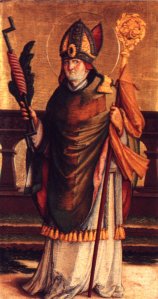In amongst the major saints celebrated during June lie the feast days of two lesser-known saints. We’re unlikely to celebrate them, but most people will have heard of them. The two saints are St Elmo (whose feast day is 2nd June) and St Vitus (15th June). They were both popular mediæval saints and became associated with unrelated phenomena.
St Elmo (died c.303, possibly) was also known as Saint Erasmus of Formiæ, a part of Italy in which he

St Elmo holding his entrails
was bishop. His life story appears to be that of a Syrian Bishop, Erasmus of Antioch, and there may never have been an historical St Elmo. The legend credits him with refusal to renounce Christ despite a number of gruesome tortures concluding with having his entrails wrapped around a windlass. Icons of St Elmo often show him holding the windlass (and entrails).
St Elmo’s fire is a blue glow emanating from tall, pointed structures (such as a ship’s mast) during a strong electric field in the atmosphere. It is an electrical discharge, and visually striking, and was thought to be a good omen by sailors. It was associated with St Elmo as he is a patron saint of sailors (and can also be called upon to protect against intestinal ailments.)
St Vitus (b. c290, d. c303) was a martyr from Sicily. He probably did exist, but our earliest record of him is just a note that he was venerated in his region. The legend about him grew up considerably later and involves him being tortured to death alongside his tutor and his nanny because he refused to turn away from Christ. He is still celebrated, although the tutor and nanny have been “de-sainted” as they appear to be fictional. He is popular in Slavic lands and his feast day is politically important in Serbia. He is a patron of actors and dancers and protector against animal attacks, lightning and oversleeping.
St Vitus’ dance (the neurological disorder Sydenham’s chorea, which causes involuntary movements superficially similar to dancing) because mediæval Germans and Latvians celebrated his feast by dancing in front of his statue.


